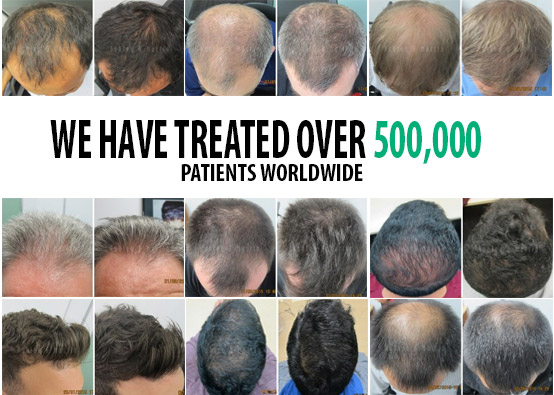
TAKE THE FIRST STEP
Free Consultation
Research advocates multifaceted treatment for hair loss
Understanding and management of all things health and medical are, by nature, always evolving. New knowledge, and its practical applications are acquired in small increments. Occasionally, though, a discovery is made of such significance that it becomes a game-changer. Newer understanding obliterates the paradigm that previously shaped our thinking and actions.
Such a fundamental shift, with the creation of a dynamic new paradigm, has emerged in the science of hair regulation and loss. The Journal of Drugs in Dermatology, in “New Insight into the Pathophysiology of Hair Loss Triggers a Paradigm Shift in the Treatment Approach,” November 2017, updates healthcare providers about these new discoveries and their long-hoped-for benefits.
More than 60 percent of men, and more than 40 percent of women, in their lifetimes, will experience a condition associated with hair loss. it. Our hair is important to our appearance and social exchanges. Hair loss can be devastating, leaving sufferers feeling hopeless. Psychological trauma is common, aggravated by the lack of treatments that are available, effective, comprehensive, and free of noxious side-effects.
Understanding hair loss starts with understanding hair structure and growth.
Hair Follicles
Hair has two distinct structures – the follicle, within the skin, and the shaft, the hair seen coming from the scalp.
The hair follicle is a tunnel-like segment of the epidermis (the outer layer of skin) that extends down into the dermis (a deeper layer of skin.) The follicle contains several layers that all have separate functions. At the base of the follicle is the papilla, which contains capillaries – tiny blood vessels that nourish the cells. The living part of the hair is the deepest aspect of the follicle surrounding the papilla, called the bulb. Two sheaths, one inner and one outer, surround the follicle. These structures protect and form the growing hair shaft. The inner sheath follows the hair shaft and ends below the opening of a sebaceous (oil) gland, vital because it produces sebum, which conditions the hair and skin.
Hair Shafts
A hair shaft is made in three layers, of a hard protein called keratin. This protein comes from dead cells; the hair that you see is not a living structure. The inner layer of the shaft is the medulla. The second layer is the cortex, and the outer layer is the cuticle. The cortex makes up most of the hair shaft. The cuticle is a tightly formed structure made of overlapping scales, like shingles on a roof. Both the cortex and the medulla hold the hair’s pigment, giving it color.
Hair Growth Cycle
Hair on the scalp grows about 0.3 to 0.4 mm/day (about 15cm per year.) Unlike other mammals, human hair growth and shedding is not seasonal. At any given time, hairs will be found in one of the three stages of growth and shedding: anagen, catagen, and telogen.
Anagen
Anagen is the active phase of hair growth. The cells in the root of the hair are dividing rapidly, forming a new hair; it pushes the club hair (a strand leaving the anagen phase of growth) up the follicle and eventually out. Each hair stays in this active phase of growth for two to six years.
Catagen
The catagen phase is transitional; about 3% of all hairs are in this phase at any time. The phase lasts for two to three weeks. Growth stops, the outer root sheath shrinks, and attaches to the root of the hair, now called a club hair.
Telogen
Telogen is the resting phase of the hair growth cycle, accounting for 6% to 8% of all hairs. It lasts for about 100 days for hairs on the scalp. Normal, daily, hair loss is 50-100 telogen-phase hairs.
Causes of Hair Loss
The causes of hair loss are many: androgen hormones; psychosocial stress, poor nutrition, genetics, autoimmune diseases, metabolic diseases, ultraviolet light, pollution, and too many others to list here. Traditionally, dermatologists have considered each case of hair loss as the result of a distinct, single cause, e.g. genetic vs acquired, scarring vs nonscarring, intrinsic vs extrinsic. Such distinctions among hair loss led to the development of drugs that target single mechanisms of loss (e.g. finasteride suppressing dihydro-testosterone DHT.)

Newer findings from the considerable research on causes of hair loss have revealed that it is a multifactorial condition, involving many factors and signaling pathways. Any treatment that targets a single feature of hair loss is destined to be incomplete, and unlikely to achieve significant hair regrowth.
A paradigm shift in hair loss treatment is necessary, from mono-targeting to multi-targeting therapeutic approaches that address not only androgens but also inflammation, oxidative stress, aging, elevated stress mediators like cortisol, their downstream signaling mediators, and which stimulate a nutrient-rich microenvironment in the hair follicle, to promote repair and structural regeneration. New, multifaceted treatments, developed for the multifactorial conditions causing hair loss, are showing restoration of hair growth at a rapid rate and density that have never been achieved previously, with treatments effective on just a single factor in hair loss. The results with multi-mechanism treatments have far surpassed all expectations of dermatologists and researchers.
Multi-targeted therapies such as low-level laser light and nutraceuticals are emerging and increasingly recognized for their efficacy as either standalone treatments or in combination with traditional hair loss protocols.
Ashley and Martin Hair Loss Treatment
Ashley and Martin Medical Hair Clinics are leading the industry in the multi-targeted approach for hair loss treatment. The basic treatment protocol includes, but is not limited to:
- RealGROWTH lotion, a unique product, developed by Ashley & Martin and available only to Ashley & Martin’s clients. It is formulated to include the most effective medical stimulant known to return hair follicles to the growth (anagen) phase. It also includes retinoids to improve scalp health.
- Use of a prescription dihydro-testosterone (DHT) inhibitor, important to controlling the androgen-associated aspects of genetic hair loss.
- Herbal products which block androgen receptors.
- Use of LLLT, either in clinic, or via the LaserPRO Plus, to decrease inflammation of the hair follicles, and to improve circulation in the scalp.
- Cleansing products free of sulphates – to ensure a healthy environment for newly growing hair.
- Trained consultants to evaluate lifestyle choices, including nutrition, that may affect hair growth.
These are just the beginning of the many and varied treatments available. A personal plan of action and selection of products will be uniquely designed for your needs and goals.
You probably have some questions or concerns about your own hair. The earlier treatment begins, the better the results. For many people, that first phone call for your free consultation is the toughest. Most wish they had called sooner.
References
1.SadickNS, CallendarVD, KircikLH, KoganSK. New insight into the pathophysiology of hair loss triggers – a paradigm shift in the treatment approach. Journal of Drugs in Dermatology Nov 2017, Vol 16, Issue 11, supplement s135.
2.Dey-Rao R, Sinha AA. A genomic approach to susceptibility and pathogenesis leads to identifying potential novel therapeutic targets in androgenetic alopecia. Genomics. 2017;109
3.Hagenaars SP, Hill WD, Harris SE, et al. Genetic prediction of male pattern baldness. PLoS Genet. 2017;13(2):e1006594
4.Heilmann-Heimbach S, Herold C, Hochfeld LM, et al. Meta-analysis identifies novel risk loci and yields systematic insights into the biology of male-pattern baldness. Nat Commun. 2017;8:14694.
5.Trueb RM. Is androgenetic alopecia a photoaggravated dermatosis? Dermatology. 2003;207(4):343-348.
6.Gatherwright J, Liu MT, Gliniak C, Totonchi A, Guyuron B. The contribution of endogenous and exogenous factors to female alopecia: a study of identical twins. Plast Reconstr Surg. 2012;130(6):1219-1226.


